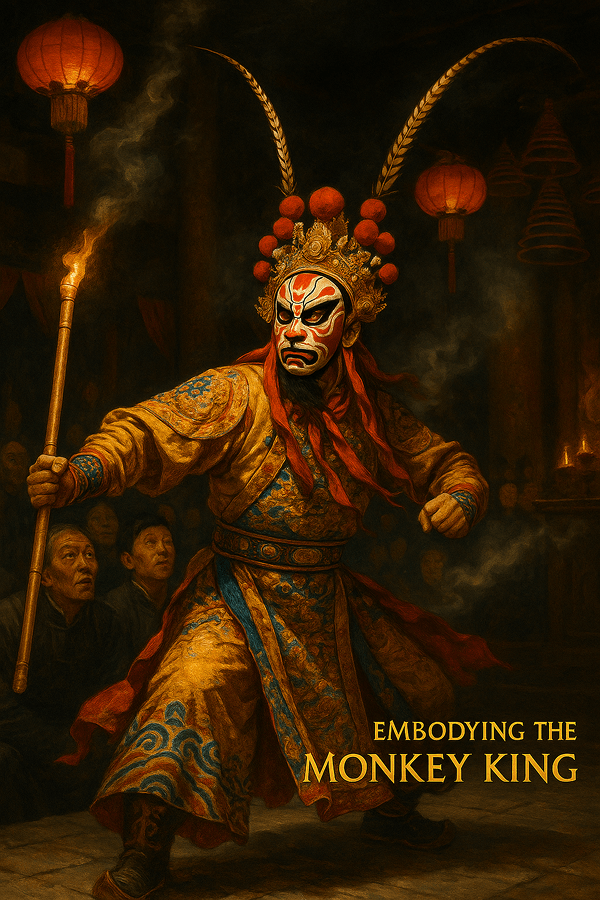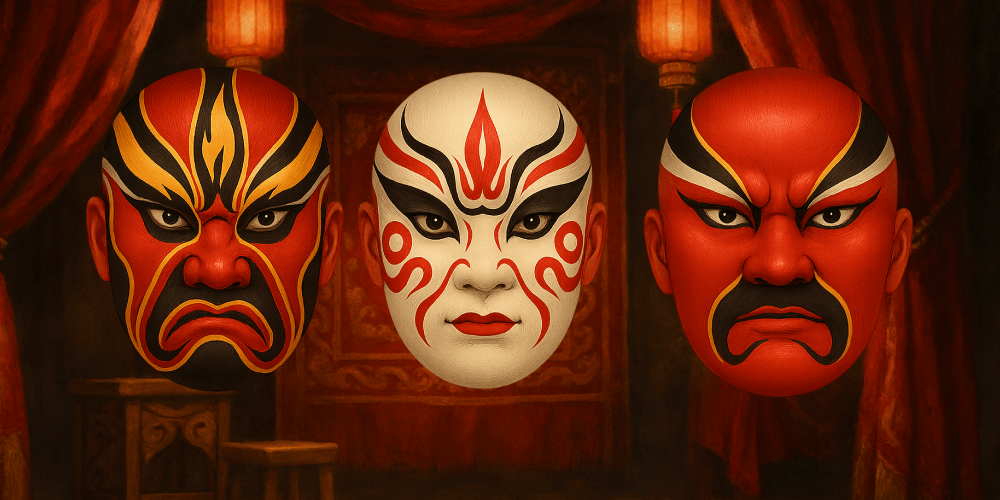Chinese Opera Masks are among the most recognizable and emblematic elements of traditional Chinese performing arts. These masks, often realized as painted faces rather than physical masks, are known for their vivid colors, bold lines, and highly stylized designs. Each mask or painted face serves as a code, immediately conveying a character’s personality, background, and fate to the audience. They are native to the heartlands of China—especially Beijing, Sichuan, and other regional centers—and have become symbols of the country’s rich cultural heritage since at least the Ming and Qing dynasties.
Historical Origins
The roots of Chinese Opera Masks stretch back over 800 years. The term most often used, “Lianpu” (脸谱, liǎnpǔ), literally means “face spectrum” and highlights the codified nature of these designs. The practice of theatrical face-painting can be traced to the Song dynasty (960–1279), but it flourished during the Yuan dynasty (1271–1368) as Chinese drama evolved. The full development of opera masks as we know them today occurred during the Ming (1368–1644) and Qing (1644–1912) dynasties, when Peking Opera became a dominant art form.
Significant historical records and artifacts provide insight into the evolution of these masks:
- Yuan Zaju scripts from the Yuan dynasty describe early use of colored facial makeup.
- Qing-era manuals document the symbolism of colors and patterns.
- Surviving wooden masks and painted face templates from this period reflect the changing aesthetics and dramatic conventions.
The evolution of mask design mirrored changes in dramatic style, theatrical technology, and social context. Early masks were physical objects, but over time, face-painting became more prominent due to its flexibility and expressive potential. The functions of the masks expanded from ritual and character differentiation to complex storytelling, satire, and social commentary.
Cultural Significance and Symbolism
Chinese Opera Masks are more than visual adornments; each color and pattern is imbued with symbolic meaning. The mask serves as a visual shorthand for complex moral and emotional states, making the performance accessible even to those unfamiliar with the story.
Some key symbolic meanings of common colors are as follows:
- Red represents loyalty and bravery.
- Black stands for integrity and strength.
- White suggests cunning or treachery.
- Blue is associated with valor and steadfastness.
- Gold and silver are often used for gods, spirits, or supernatural beings.
Spiritually, the masks are believed to channel the essence of the character, allowing the performer to inhabit mythic archetypes or historical figures. Many masks draw on ancient mythological motifs, such as the demon-slaying hero Zhong Kui or the Monkey King Sun Wukong. In some cases, masks are associated with exorcism rituals and festival celebrations, linking them to both religious and secular life.

Materials and Craftsmanship
The creation of traditional opera masks blends artistry and technical skill. While some regional operas use physical masks carved from lightweight woods and finished with lacquer and paint, the most iconic form is face-painting—applied directly to the actor’s skin with mineral pigments and natural dyes.
The process of making a Chinese Opera Mask or painted face generally involves several steps:
- Applying a base layer of white or skin-colored paint.
- Using fine brushes to paint intricate designs, following strict iconographic rules.
- Employing special tools and stencils for symmetrical and detailed patterns.
- Adding decorative elements such as feathers, metal accents, or sequins in some regional traditions.
There are notable regional distinctions in craftsmanship. For example, Peking Opera is known for its elegant, codified patterns, while Sichuan Opera features more exaggerated and dynamic designs. The choice of colors and decorative motifs often reflects local customs, religious beliefs, and the historical evolution of the opera.
Functions and Uses
Chinese Opera Masks serve several important purposes in Chinese society. Their primary role is theatrical: they define character archetypes and instantly communicate emotional and moral cues to the audience.
Other uses and their evolution include:
- Participation in festivals, temple fairs, and ceremonial parades.
- Use in exorcistic rituals and seasonal celebrations.
- Expansion from ritual and religious functions to popular entertainment, education, and political satire.
- Modern roles in cultural tourism, art exhibitions, and educational outreach, as well as symbols of Chinese national identity.
Regional Variations
There is considerable regional diversity in the design and use of Chinese Opera Masks. Each region has developed its own style, technique, and symbolic language. For example:
- In Peking Opera, masks are typically painted directly onto the actor’s face, following a strict color code and pattern system.
- Sichuan Opera is famous for the “face-changing” (Bian Lian) technique, where performers switch between multiple masks in seconds to signify emotional or narrative shifts.
- Yue Opera from southern China uses softer colors and more delicate designs.
- Henan Opera and Qinqiang Opera from the north-west have their own distinctive visual vocabularies.
When compared to other cultures, Chinese Opera Masks are more codified and symbolic than Japanese Noh masks or Korean Tal masks, which tend to focus on realism or stylized caricature.
Famous Examples and Collections
Many historic opera masks and face-painting templates are preserved in museums and private collections. Here are some of the most notable examples and places to see them:
- National Museum of China, Shanghai Museum, and Capital Museum in Beijing house important collections of antique masks and face charts.
- The Xi’an Opera Museum displays regional varieties and rare artifacts from northwest China.
- Online galleries like toddmasks.com offer access to rare and unique examples, including antique wooden masks and hand-painted face charts used by master performers.
Some of the most famous mask designs represent legendary figures such as Bao Zheng (a symbol of justice, always painted with a black face) and Guan Yu (depicted with a red face for loyalty).
Influence on Art and Culture
Chinese Opera Masks have exerted a significant influence on Chinese and global culture. Their bold designs have inspired artists, designers, and filmmakers.
They have made an impact in various fields:
- Painting, sculpture, poster and graphic design, and even fashion, where mask motifs appear in contemporary clothing and accessories.
- Chinese literature, cinema, and popular media, where opera masks are referenced or depicted.
- Advertising, animation, and music, where their imagery is used to evoke drama and tradition.
- Efforts to preserve intangible cultural heritage, serving as a bridge between traditional and popular culture and as a source of national pride.
Contemporary Status and Preservation
Today, the tradition of opera mask-making and face-painting is kept alive by both established opera schools and independent artists. Major schools in Beijing, Shanghai, and Chengdu train new generations of performers in the craft.

Modern preservation and adaptation efforts include:
- Public education through museum programs, master classes, and educational outreach (some featured on toddmasks.com).
- Government support for intangible cultural heritage programs and academic research.
- International collaboration, with exchanges between Chinese and global artists.
- Contemporary adaptations in experimental theatre, multimedia installations, and fusion performances that blend opera masks with global art forms.
Collecting and Acquiring
Collecting Chinese Opera Masks can be both rewarding and complex. The market includes everything from affordable, modern reproductions to rare antiques.
If you are interested in acquiring a mask, consider the following points:
- Authentic masks can be acquired from reputable galleries, auction houses, and specialized dealers.
- Prices vary widely, depending on age, materials, condition, and historical significance.
- Always pay attention to authenticity and provenance, seeking expert advice or documentation when possible.
- Consider ethical issues, such as the provenance of antique masks and the cultural rights of local communities.
- Platforms like toddmasks.com often provide guidance and resources to help collectors make informed, responsible purchases.
Chinese Opera Masks are a testament to the artistic ingenuity and narrative power of Chinese culture. They are a living tradition, continuing to inspire and evolve through new generations of artists and performers. Their symbolic language, visual drama, and roots in ritual and performance make them unique in the world of theatre and art. As preservation and adaptation continue, Chinese Opera Masks remain an enduring link between past and present—a vibrant part of China’s cultural legacy and a source of fascination for art lovers worldwide.
